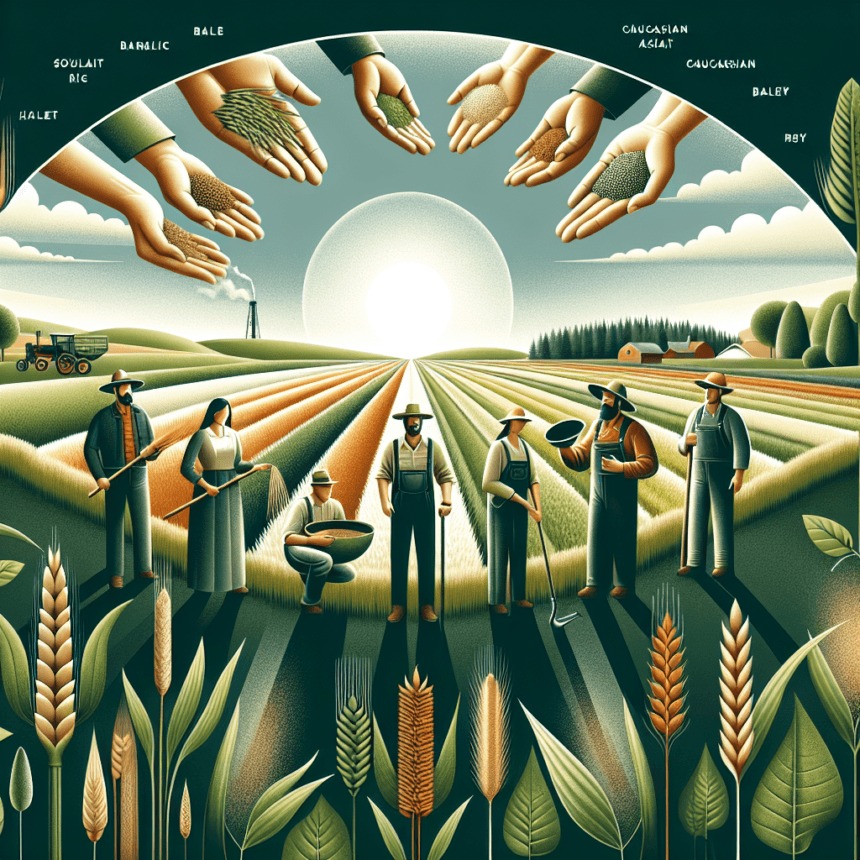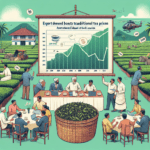Main Points In Hindi (मुख्य बातें – हिंदी में)
यहां दिए गए पाठ के 3 से 5 मुख्य बिंदु निम्नलिखित हैं:
-
सतत विकास के लिए कृषि का महत्व: सतत विकास के 2030 एजेंडे में कृषि को केंद्रीय भूमिका दी गई है, जो आर्थिक, सामाजिक, और पर्यावरणीय विकास के लिए महत्वपूर्ण है। कृषि की सहायता से गरीबी और भूख को समाप्त करने तथा जलवायु परिवर्तन से निपटने में मदद मिलती है।
-
अभूतपूर्व खाद्य असुरक्षा: 2023 में, लगभग 2.33 बिलियन लोग मध्यम या गंभीर खाद्य असुरक्षा का सामना कर रहे हैं, जिसमें से 864 मिलियन लोग गंभीर स्थिति में हैं। यह स्थिति वैश्विक खाद्य संकट की गंभीरता को दर्शाती है।
-
भविष्य की खाद्य मांग: 2050 तक वैश्विक जनसंख्या 9.8 बिलियन तक पहुँचने का अनुमान है, जिसके परिणामस्वरूप खाद्य उत्पादन में लगभग 60% की वृद्धि करने की आवश्यकता होगी। इस मांग को पूरा करने के लिए एक स्थायी खाद्य प्रणाली विकसित करने की आवश्यकता है।
-
अर्थव्यवस्था में कृषि का योगदान: कृषि क्षेत्र न केवल खाद्य सुरक्षा में सहायक है, बल्कि यह रोजगार सृजित करने और आर्थिक विकास में भी महत्वपूर्ण भूमिका निभाता है। विश्व स्तर पर और विशेषकर भारत, अमेरिका और ब्राजील जैसे देशों में, कृषि क्षेत्र का GDP में महत्वपूर्ण योगदान है।
- सभी के लिए समृद्धि सुनिश्चित करना: 2030 का एजेंडा सभी के लिए समृद्धि, ग्रह की सुरक्षा, और सामाजिक समानता को सुनिश्चित करने के लिए वैश्विक स्तर पर कार्य करने का आह्वान करता है। इसके लिए कृषि में निवेश और ग्रामीण विकास को प्राथमिकता देना महत्वपूर्ण है।
Main Points In English(मुख्य बातें – अंग्रेज़ी में)
Here are the main points summarized from the provided content:


-
Importance of Agricultural Development: The central theme of sustainable development revolves around improving human well-being, and agricultural focus is crucial for addressing nutritional needs, thereby contributing to overall welfare. Sustainable food supply through agriculture must be prioritized alongside investments in housing, healthcare, education, and infrastructure.
-
2030 Agenda for Sustainable Development: Adopted by UN member states in 2015, this agenda emphasizes the interconnection between food security, natural resource management, and livelihoods. It includes 17 Sustainable Development Goals (SDGs), which address poverty eradication, equality, planetary protection, and universal prosperity for all by 2030.
-
Food Insecurity Crisis: In 2023, approximately 2.33 billion people faced food insecurity globally, with millions experiencing severe food shortages. This highlights an urgent need for effective interventions to combat hunger and malnutrition, especially as global food demand is expected to increase significantly by 2050.
-
Economic Contribution of Agriculture: Agriculture plays a vital role in global economies. It employs over 800 million people, constitutes a significant portion of GDP in many countries, and is essential for poverty reduction and food security, particularly in rural areas. The agricultural sector’s contributions vary by country, with the U.S., Brazil, China, and India being major players in food production and exports.
- Call to Action: Emphasizing the necessity for intentional investment in agriculture, the text advocates for prioritizing rural development and collaboration among global agencies to mobilize resources effectively, ensuring that sustainable development targets are met for poverty alleviation and food security.
Complete News In Hindi(पूरी खबर – हिंदी में)
प्रिंस एसजे सैमुअल द्वारा: कृषि का महत्व और सतत विकास के लिए 2030 एजेंडा
प्रत्येक विकासात्मक पहल का उद्देश्य लोगों की भलाई को बढ़ाना है। इसके लिए विभिन्न क्षेत्रों जैसे आवास, स्वास्थ्य देखभाल, शिक्षा और बुनियादी ढांचे पर ध्यान देने की आवश्यकता है। हालांकि, कृषि और इसके माध्यम से खाद्य सुरक्षा सबसे महत्वपूर्ण है। यह न केवल लोगों की भलाई में योगदान करता है, बल्कि समाज के समस्त रुझानों से भी जुड़ा हुआ है।
2030 एजेंडा और कृषि
2030 एजेंडा, जो 2015 में संयुक्त राष्ट्र के सदस्य देशों द्वारा अपनाया गया, सतत विकास के लिए एक व्यापक रूपरेखा प्रदान करता है। इसमें 17 सतत विकास लक्ष्य (एसडीजी) शामिल हैं, जिनका उद्देश्य गरीबी को समाप्त करना, समानता को बढ़ावा देना, और पर्यावरण की सुरक्षा करना है। कृषि को इस एजेंडे का केंद्रीय तत्व माना गया है क्योंकि यह खाद्य सुरक्षा, आजीविका, और प्राकृतिक संसाधनों के प्रबंधन में विशेष भूमिका निभाता है।


खाद्य असुरक्षा की स्थिति
2023 में, वैश्विक स्तर पर 2.33 अरब लोग खाद्य असुरक्षा का सामना कर रहे थे। इनमें से 860 मिलियन से अधिक लोगों ने गंभीर खाद्य असुरक्षा का अनुभव किया। भोजन की कमी के चलते ग्रहीय संकट तेजी से बढ़ रहा है। यह मौजूदा रुझानों के आधार पर अनुमान लगाया गया है कि 2030 में लगभग 582 मिलियन लोग अल्पपोषित रहेंगे, जिनमें से आधे अफ्रीका में होंगे।
वैश्विक जनसंख्या और कृषि उत्पादन की आवश्यकता
संयुक्त राष्ट्र के अनुमानों के अनुसार, 2050 तक वैश्विक जनसंख्या 9.8 अरब तक पहुंच जाएगी। इसके परिणामस्वरूप खाद्य उत्पादन में लगभग 60% की वृद्धि की आवश्यकता होगी। इस चुनौती का सामना करने के लिए विकसित देशों को अपनी कृषि उत्पादकता बढ़ाने के लिए आधुनिक तकनीकों का उपयोग करना होगा।
कृषि का आर्थिक महत्व
कृषि न केवल खाद्य सुरक्षा में योगदान देती है, बल्कि यह अर्थव्यवस्था में भी महत्वपूर्ण भूमिका अदा करती है। 2021 में, विश्व बैंक के डेटा के अनुसार, कृषि ने 800 मिलियन से अधिक लोगों को रोजगार प्रदान किया। अमेरिका में कृषि ने 2020 में 10% रोजगार का हिस्सा बनाया, जबकि यूरोपीय संघ में इसका योगदान 1.3% था।
मुख्य कृषि उत्पादक देश
- चीन: विश्व की कुल कृषि योग्य भूमि का 10% होते हुए भी, यह वैश्विक जनसंख्या का 20% से अधिक का खाद्य उत्पादन करता है।
- संयुक्त राज्य अमेरिका: यह कृषि का सबसे बड़ा शुद्ध निर्यातक है, जिसका कृषि निर्यात 2023 में 174 अरब डॉलर तक पहुंच गया।
- ब्राजील: यह कृषि और औद्योगिक उत्पादों का एक प्रमुख उत्पादक है, जिसने 2023 में निर्यात में 166.55 बिलियन डॉलर की वृद्धि दर्ज की।
- भारत: भारत 2023 में कृषि उत्पादों का आठवां सबसे बड़ा निर्यातक बना हुआ है, हालांकि इसके कृषि निर्यात में कुछ कमी आई है।
निष्कर्ष
सतत विकास के लिए 2030 का एजेंडा कृषि की महत्वपूर्ण भूमिका को मान्यता देता है। इससे यह स्पष्ट होता है कि कृषि में जानबूझकर निवेश और ग्रामीण विकास को प्राथमिकता देना आवश्यक है। इसके लिए, वैश्विक एजेंसियों और सरकारों को एक साथ मिलकर कार्य करने की आवश्यकता है, ताकि खाद्य सुरक्षा को सुनिश्चित किया जा सके और भूख तथा poverty को समाप्त किया जा सके।
सारांश में, समय की आवश्यकता है कि सभी देश, विशेष रूप से विकासशील, कृषि की ताकत को समझें और इसे अपने आर्थिक विकास के लिए प्राथमिकता दें। सतत विकास के लक्ष्यों को प्राप्त करने के लिए कृषि का समर्थन केवल एक विकल्प नहीं, बल्कि एक आवश्यकता है।
Complete News In English(पूरी खबर – अंग्रेज़ी में)
Summary of "农业与可持续发展:2030年议程的重要性" by Prince SJ Samuel, Chairman, Origin Tech Group
The essence of every developmental initiative lies in enhancing the well-being of people. The tangible implications recommend a comprehensive focus on housing development, investment in science and technology, healthcare, education, and infrastructure provision (including roads, rail systems, ports, airports, and low-cost broadband internet access). However, the prime importance of sustainable food supply to meet the nutritional needs of populations remains a core foundation for overall well-being, necessitating a central focus on agriculture.
The Centrality of Agriculture in the 2030 Agenda
The 2030 Agenda for Sustainable Development provides a comprehensive framework adopted by UN member countries in 2015 to tackle global challenges and ensure sustainable progress across economic, social, and environmental dimensions. At its heart are 17 Sustainable Development Goals (SDGs) and 169 targets aimed at eradicating poverty, promoting equality, protecting the planet, and fostering peace and prosperity for all. This initiative acts as a universal call to action, addressing multiple dimensions of sustainable development while stressing the interconnectedness of food security, livelihoods, and natural resource management.
Investment in agriculture, prioritizing rural development, and focusing on crops, livestock, forestry, fishing, and aquaculture are essential steps to eradicate poverty and hunger while advancing sustainable development. Furthermore, agriculture plays a crucial role in addressing climate change and its consequences. The journey from eradicating poverty and hunger to responding to climate change and sustaining our natural resources, food, and agriculture lies at the core of the 2030 Agenda, poised to support the full set of SDG initiatives.
The Urgency of the Situation
As of 2023, approximately 2.33 billion people globally faced moderate to severe food insecurity. This figure, which saw a significant surge during the COVID-19 pandemic in 2020, has shown little improvement since then. Over 864 million individuals experienced severe food insecurity, often going without food for an entire day. A report from the Food and Agriculture Organization (FAO) in 2022 indicated that around 258 million people faced crisis-level food insecurity across 58 countries and regions, representing a sharp increase from 193 million the previous year. The Global Report on Food Crises (GRFC) 2023 highlighted a continued rise in individuals experiencing high levels of severe food insecurity for the fourth consecutive year, calling for immediate food interventions and livelihoods support.
Warnings from the G20 Global Coalition’s ministerial meeting in Brazil highlighted the significant gap between current trends and achieving the SDG 2 target of zero hunger by 2030. Major global bodies like FAO, IFAD (International Fund for Agricultural Development), UNICEF, WFP (World Food Programme), and WHO project that if current trends continue, nearly 582 million individuals will remain undernourished by 2030, with a considerable number residing in Africa.
The Need to Feed a Growing Population
The UN predicts that the global population will reach 9.8 billion by 2050, necessitating a staggering 60% increase in food production to feed this additional two billion people. The global food system must find funding and ways to meet this demand effectively.
Agriculture: A Pathway Out of Poverty
As of 2021, over 800 million people were employed in agriculture, representing 27% of the global workforce. Agriculture has a pivotal role in reducing poverty, increasing income, and enhancing food security for about 80% of the world’s poor, particularly those in rural areas dependent on agriculture for their livelihoods. The U.S. Department of Agriculture (USDA) reported that agriculture contributed 10% of all U.S. employment in 2020, with cash receipts from crop and livestock activities reaching approximately $198 billion and $165 billion, respectively. Agriculture accounts for around 4% of global GDP according to the World Bank.
The Flourishing Influence of Agriculture
Agriculture impacts society by providing food, maintaining livelihoods, creating housing, and generating employment opportunities. Countries with higher agricultural productivity and robust infrastructure exhibit greater per capita income due to their adoption of advanced technology and better agricultural management practices. These nations play a critical role in sustaining the global population by significantly contributing to the overall food supply.
Case Studies of Major Agricultural Players
-
China:
China represents about 18% of the global population and has only 10% of the world’s arable land but meets the alimentary needs of more than 20% of the global population. Its total food production reached 687 million tons in 2023, maintaining a level above 650 million tons for the eighth consecutive year. Notably, grain production accounted for about 23% of global grain output. Despite its limited land resources, agriculture employs nearly 50% of China’s workforce. -
United States:
The U.S. is the largest country by land area and a net exporter of food. Mechanized farming has made it a leader in crop production. Over the past 25 years, U.S. agricultural exports have steadily increased, showcasing the dynamic changes in global supply and demand dynamics. In 2023, the agricultural and food sectors contributed approximately $1.53 trillion to the U.S. economy, roughly 5.6% of GDP. -
Brazil:
Recognized as a major agricultural and industrial powerhouse in Latin America, Brazil excels in producing commodities such as coffee, sugar, soybeans, beef, and poultry. The poverty rate in Brazil significantly dropped from 64% in 1990 to 28% by 2021. The agricultural and food sector accounted for nearly 29% of Brazil’s GDP in 2021, worth $1.8 trillion. Brazilian agribusiness exports reached an unprecedented level of $166.55 billion in 2023, underlining its pivotal role in the country’s export activities. - India:
India ranks as the second-largest global producer of various commodities, including nuts, textiles, pulses, and vegetables. Despite a decrease in agricultural exports from $55 billion in 2022 to $51 billion in 2023, India maintains its position as the eighth-largest exporter of agricultural products. The agricultural sector contributes approximately 18-19% to India’s GDP.
Time to Roll Up Sleeves
Recognizing the fundamental role agriculture plays in achieving the highlighted objectives of the 2030 Agenda is crucial for eradicating poverty and ensuring prosperity for all. Therefore, deliberately prioritizing investment in agriculture and rural development has become an essential strategy for combating poverty and hunger while promoting sustainable development. Relevant governmental agencies and international organizations, including FAO, IFAD, UNICEF, WFP, and WHO, must collaborate to accelerate action and mobilize sufficient resources in this regard.
In conclusion, addressing the critical intersection of agriculture and sustainable development through concerted global efforts and investments is paramount to meet the pressing challenges of food security and to foster a more prosperous future for all by 2030.




